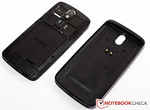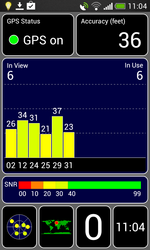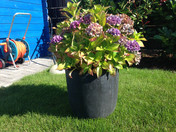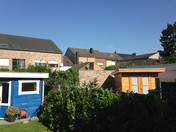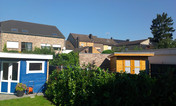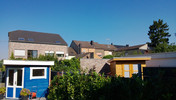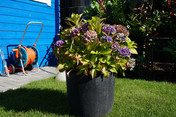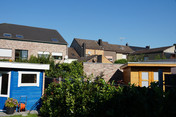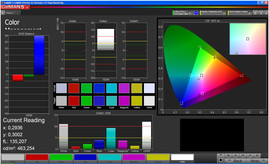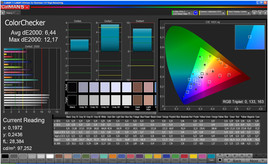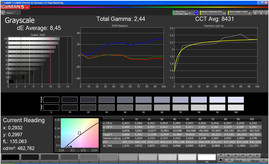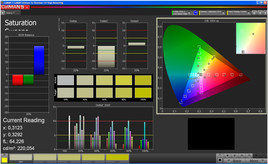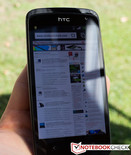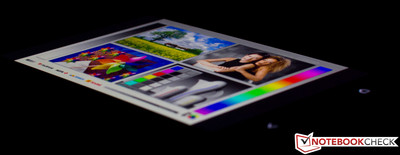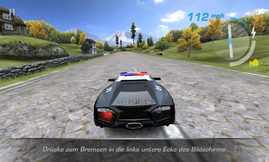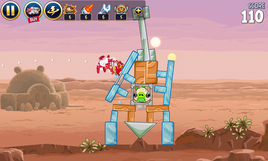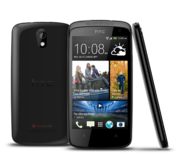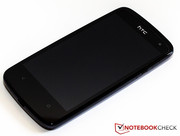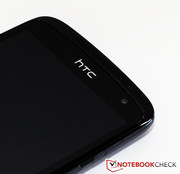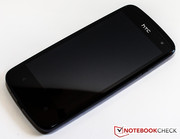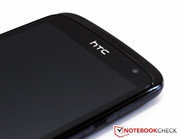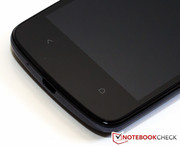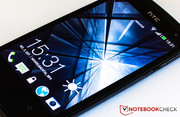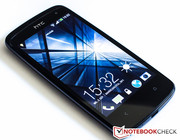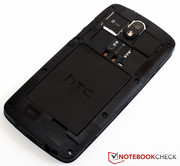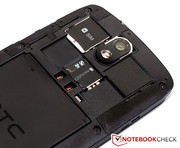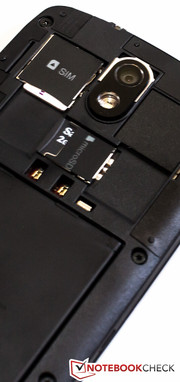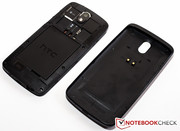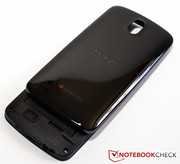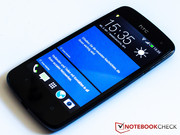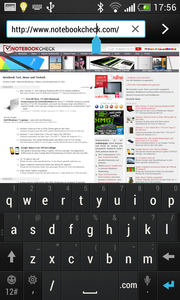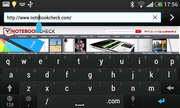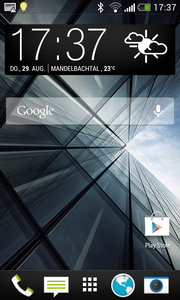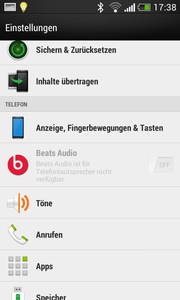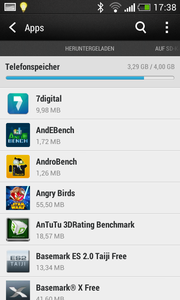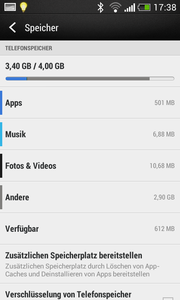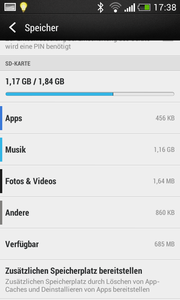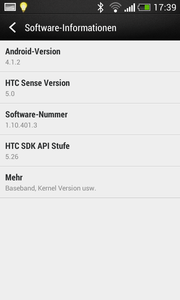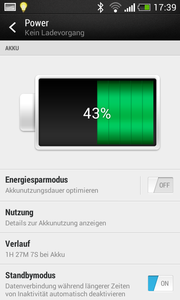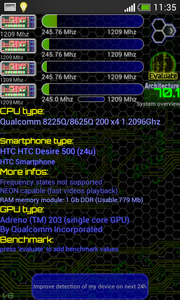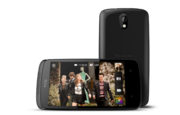Review HTC Desire 500 Smartphone
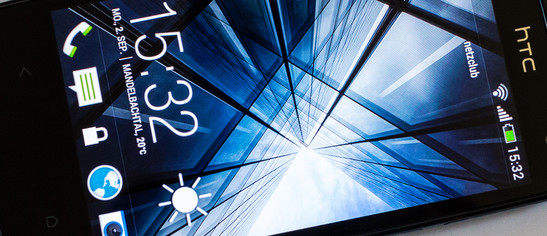
For the original German review, see here.
HTC offers another 4.3-inch device with the Desire 500; we just recently reviewed the similarly sized One Mini. Our dream device would be a combination of both: An aluminum unibody case with a removable battery and expandable storage - but that is just wishful thinking, back to the reality. A micro SD slot and a removable battery are certainly two important features of the Desire 500, similar to the Galaxy S4 Mini and quite the opposite of the One Mini. The quad-core SoC is based on the Snapdragon 200 series; the mainstream smartphone has 1 GB memory and the Adreno 203 GPU. It is also less expensive than the two competitors with a retail price of 279 Euros (~$370), but can the Desire 500 keep up with the rivals?
Case
The case of the Desire 500 is very similar to the HTC Sensation; the design and the locking mechanism of the back cover are almost identical. Our review unit has a back cover with a black sleek finish. The subjective impression of the build quality does suffer from that and the whole device easily attracts fingerprints. We can also see several small scratches on the glossy black cover after a few days. Unfortunately, they cannot be avoided if you use the smartphone. Our review unit shows a high torsion and pressure resistance, despite the lack of an aluminum unibody. It is quite tricky to open the device at the beginning because you don't really know where to grab the phone.
Our review unit is slightly smaller than the HTC One Mini with dimensions of 66.9 x 131.8 x 9.9 mm (width x length x height), but noticeably bigger than the S4 Mini. We were surprised by the weight, it is even 1 gram heavier than the One Mini (122 grams), which is made of metal.
Connectivity
Expectations should not be too high in terms of storage capacity, 4 GB internal flash storage is not really generous nowadays. Fortunately, it can be expanded via micro SD slot.
We can clearly see a pattern in terms of port layout. HTC usually locates the power button and the 3.5 mm stereo jack at the top. Almost every manufacturer integrates the micro USB port at the bottom and the volume rocker can either be found at the left or right side of the case.
Software
Since HTC does not produce Windows Phone 8 devices anymore, the Desire 500 is using Android 4.1.2 (Jelly Bean) in combination with the latest version of HTC's launcher Sense; one popular feature is HTC BlinkFeed. It is nice that HTC does not preinstall many applications, there are no third-party applications besides the usual Google applications like Gmail, Chrome or Google+.
Communication & GPS
Our review unit is equipped with the usual communication modules, including WLAN (802.11 b/g/n) or Bluetooth 4.0 with aptX support. Unfortunately, the WLAN module does not support dual band and there is no LTE module either, but you get UMTS/HSPA with a maximum download speed of 7.2 Mbit/s. We could not determine any surprising connection losses in our tests. You can use DLNA to stream content from your home network.
There is an aGPS module to use all the features of Google Maps or other navigation software. It takes some time before the connection with the satellites is established indoors and the accuracy could be better. The situation changes outdoors; satellites are easily found and the accuracy is good.
Telephone Function & Voice Quality
The mainstream device has no problems with the most important function of a smartphone, making calls. The person on the other side is loud and clear. We could not determine any background noise or other restrictions, at least with sufficient signal strength. The built-in hands free function works but it can be hard to understand everything on the highway or in louder environments, for instance. However, you can use the provided in-ear headset in these scenarios.
Cameras & Multimedia
There was a lot of information in regard to the cameras on the manufacturer's website. The larger sensor is on the back and takes pictures with 8 megapixels and is supported by an LED flash. The size of the BSI sensor is 0.312 inches with an aperture of f/2.4 and a 28 mm lens. The front camera has a resolution of up to 1.6 megapixels and can record HD videos (720p) - just like the main camera.
Compared to our reference camera, the picture quality of the Desire 500 is reasonable. The colors are very accurate and there are many details. Darker pictures or close-ups show that the pictures are slightly overexposed. The pictures are therefore brighter compared to our reference camera. All in all, a really good result.
Accessories & Warranty
The box of our review unit contained a modular power supply unit and an in-ear headset. There are no additional accessories, you will have to get them from other retailers.
The warranty period of this smartphone is 24 months.
Input Devices & Handling
Similar to basically every other smartphone, the touchscreen is the main input device and is complemented by a virtual keyboard. The same applies for the Desire 500. The two soft keys for the Android operating system are beneath the display; there would have been enough space for another button between the Back and the Home button. The whole navigation area is quite big and occupies too much space for our taste.
The display reacts very precisely and can handle up to ten inputs simultaneously, however, you will have to deactivate the setting HTC Finger Movement. The accelerometer reacts very quickly to position changes and adjusts the display orientation accordingly.
About 40% of the screen area is occupied by the virtual keyboard in portrait mode. But it is even more crowded in landscape mode, where the keyboard uses 50% of the screen.
Display
The competition in the market of 4.3-inch smartphones is fierce. Samsung's Galaxy S4 Mini and HTC's One Mini are two interesting devices with this screen size. The Desire 500 has a resolution of 800x480 pixels (WVGA) and a pixel density of 217 ppi. This is one category where the S4 Mini (256 ppi) and the One Mini (341 ppi) can surpass our review unit.
We used our standard tests to determine the luminance of the display. A maximum brightness of 468 cd/m² is a very high result and the average brightness of 430 cd/m² is very close to the 466.1 cd/m² of the HTC One Mini. Unfortunately, the black value is very high with 0.8 cd/m² and affects the contrast ratio; 585:1 is just average, just like the brightness distribution of 85%.
| |||||||||||||||||||||||||
Brightness Distribution: 85 %
Center on Battery: 468 cd/m²
Contrast: 585:1 (Black: 0.8 cd/m²)
ΔE ColorChecker Calman: 6.44 | ∀{0.5-29.43 Ø4.77}
ΔE Greyscale Calman: 8.45 | ∀{0.09-98 Ø5}
Gamma: 2.44
CCT: 8431 K
We determine big deviations for blue and white, an average DeltaE value of 6.44 is too high. As a result, the difference can be interpreted as another color. The grayscale presentation is very close to the ideal value, but it is noticeable that some steps are too bright; the color temperature is very cool.
Thanks to the high display brightness, you can easily use the smartphone outdoors, even the mediocre contrast ratio cannot change that. Perhaps you should consider an anti-reflective display protection. It could improve the visibility under direct sunlight and also prevent annoying fingerprints.
The viewing angle stability of the LCD-TFT screen is very good. Contrary to the result of the IdeaTab A1000, the Desire 500 shows a consistent picture from any angle.
Performance
HTC equips the Desire 500 with a Qualcomm SoC, the Snapdragon 200 8225Q. The quad-core CPU has a clock of 1.2 GHz and is produced in a 45 nm manufacturing process. It supports the ARMv7 instruction set and can use 1 GB memory.
Galaxy S4 Mini and One Mini only have dual-core SoCs, however, you should not underestimate the performance of these SoCs. The clocks, for instance, are higher compared to our review unit. We used several synthetic benchmarks to determine the performance.
As expected, the results of these benchmarks are sobering. Despite the quad-core CPU, the performance cannot keep up with the One Mini or the S4 Mini. Even the currently very cheap Nexus 4 is 622% better. Only the ZTE Blade III can be beaten by our review unit. One note at this point: We could not run Basemark X Free, the benchmark did not work properly.
| AnTuTu v3 - Total Score (sort by value) | |
| HTC Desire 500 | |
| HTC One Mini | |
| Samsung Galaxy S4 Mini GT-I9195 | |
| Google Nexus 4 | |
| Acer Liquid E2 v370 | |
| ZTE Blade III | |
| Geekbench 2 - 32 Bit - Total Score (sort by value) | |
| HTC Desire 500 | |
| HTC One Mini | |
| Samsung Galaxy S4 Mini GT-I9195 | |
| Google Nexus 4 | |
| Acer Liquid E2 v370 | |
| ZTE Blade III | |
| GFXBench (DX / GLBenchmark) 2.7 | |
| T-Rex Onscreen (sort by value) | |
| HTC Desire 500 | |
| HTC One Mini | |
| Samsung Galaxy S4 Mini GT-I9195 | |
| Google Nexus 4 | |
| Acer Liquid E2 v370 | |
| ZTE Blade III | |
| 1920x1080 T-Rex Offscreen (sort by value) | |
| HTC Desire 500 | |
| HTC One Mini | |
| Samsung Galaxy S4 Mini GT-I9195 | |
| Google Nexus 4 | |
| Acer Liquid E2 v370 | |
The results of the browser-based benchmarks are better than the synthetic results. Our review unit can even surpass the Nexus 4 or the Galaxy S4 Mini sometimes.
| Google V8 Ver. 7 - Google V8 Ver. 7 Score (sort by value) | |
| HTC Desire 500 | |
| HTC One Mini | |
| Samsung Galaxy S4 Mini GT-I9195 | |
| Google Nexus 4 | |
| Acer Liquid E2 v370 | |
| ZTE Blade III | |
| Browsermark - --- (sort by value) | |
| HTC Desire 500 | |
| HTC One Mini | |
| Samsung Galaxy S4 Mini GT-I9195 | |
| Google Nexus 4 | |
| Octane V1 - Total Score (sort by value) | |
| HTC Desire 500 | |
| HTC One Mini | |
| Samsung Galaxy S4 Mini GT-I9195 | |
| Google Nexus 4 | |
| Acer Liquid E2 v370 | |
| Sunspider - 1.0 Total Score (sort by value) | |
| HTC Desire 500 | |
| HTC One Mini | |
| Samsung Galaxy S4 Mini GT-I9195 | |
| Google Nexus 4 | |
| Acer Liquid E2 v370 | |
| Peacekeeper - --- (sort by value) | |
| HTC Desire 500 | |
| HTC One Mini | |
| Samsung Galaxy S4 Mini GT-I9195 | |
| Google Nexus 4 | |
| Acer Liquid E2 v370 | |
| ZTE Blade III | |
* ... smaller is better
However, the performance of the integrated flash memory is really bad. Even the ZTE Blade III shows a better performance in three out of four tests. The One Mini is 354% ahead of the Desire 500.
Videos & Games
We use several sample movies to stress the hardware. Playback of HD trailers (720p) is usually very smooth with the integrated application, but there are problems with Full HD playback. The integrated player refuses to work and we have to use third-party apps from the Play Store. Full HD playback works with MX Player but the application uses software decoding since the hardware is not powerful enough. But you can save yourself the trouble, the playback is not smooth even with this solution. The hardware is just too slow.
We did not have these problems with 2D or 3D games. The tested apps showed no problems and we enjoyed playing with the Desire 500.
Emissions
Temperature
The temperature development of the Desire 500 is excellent. We measure an average temperature of 36.7 °C at the front and 34.8 °C at the back under load. Samsung's competitor Galaxy S4 Mini is slightly warmer, just like the One Mini. The average temperature during idle is 30.8 °C (front) and there is subjectively no difference to the One Mini or S4 Mini. However, that cannot be said about the power supply unit, which is very hot with almost 50 °C under load.
(+) The maximum temperature on the upper side is 39.1 °C / 102 F, compared to the average of 35.2 °C / 95 F, ranging from 21.9 to 247 °C for the class Smartphone.
(+) The bottom heats up to a maximum of 37.8 °C / 100 F, compared to the average of 34 °C / 93 F
(+) In idle usage, the average temperature for the upper side is 30.8 °C / 87 F, compared to the device average of 32.9 °C / 91 F.
Speaker
Even the mainstream smartphone is equipped with Beats Audio. Contrary to the HTC One-series there is just one speaker at the back. The case opening suggests a very wide unit but that is not the case. You can see that the speaker is very small once you remove the back cover. There is another speaker at the front, but it is exclusively used for calls.
The position of the speaker results in distortions when the smartphone is lying on a flat surface. The maximum volume is sufficient and can be used without affecting the sound quality too much. There are only some small distortions but the overall sound experience is very focused on high tones, which is somewhat annoying.
Energy Management
Power Consumption
The comparison with the S4 Mini and the One Mini shows that our review unit consumes more energy; between 1.5 and 3.1 Watts during idle. HTC's One Mini (0.6 up to 1.3 Watts) and Samsung's S4 Mini (0.3 and 1.2 Watts) are considerably more frugal. It is the same situation under load, our Voltcraft VC 940 measures between 3.3 and 4.4 Watts, while the One Mini only consumes between 2.9 and 3.8 Watts with faster hardware. Especially bad is the consumption during standby; the Desire 500 needs 0.7 Watts. This is seven times the consumption of many rivals and should have a negative impact on the battery runtime.
| Off / Standby | |
| Idle | |
| Load |
|
Key:
min: | |
Battery Runtime
We already mentioned the comparatively high energy consumption; the battery runtimes are not a strong suit of the Desire 500. We determine a reasonable runtime of 2:48 hours under load, but the other scenarios are affected by the high idle and standby consumption. 7:40 hours in our WLAN scenario is almost 80 minutes less than the One Mini and 4.5 hours less than the S4 Mini. The situation is similar during idle where the battery manages 14 hours. The PSU needs 2:05 hours to recharge an empty battery with an activated but unused device.
You can also purchase an additional battery if you need longer battery runtimes. The back cover is removed within seconds and you can easily replace the battery.
Verdict
We used our Desire 500 review unit over the last couple of days. The smartphone is equipped with a Qualcomm Snapdragon 200 quad-core SoC and supports the common wireless standards WLAN, Bluetooth, GPS and even NFC. Contrary to many HTC devices you can expand the internal storage (4 GB) and also replace the battery. A display resolution of 800x480 pixels is not up to date anymore and cannot compete with the HTC One Mini, for instance. The picture quality of the main camera is surprisingly decent and the maximum display brightness is sufficient outdoors. However, multimedia capabilities are limited because the SoC cannot handle Full HD videos.
The mainstream device is currently available for a street price of around 280 Euros (~$371)in two different colors. The similarly sized HTC One Mini is almost 150 Euros (~$199) more expensive and you can get the S4 Mini for 350 Euros (~$464). Both alternatives are definitely worth considering, but you will be satisfied with the Desire 500 if you can live with the drawbacks. Another interesting alternative is the Google Nexus 4 that just got a price cut of 100 Euros (~$132); the 8 GB version is currently available for 200 Euros (~$265).


